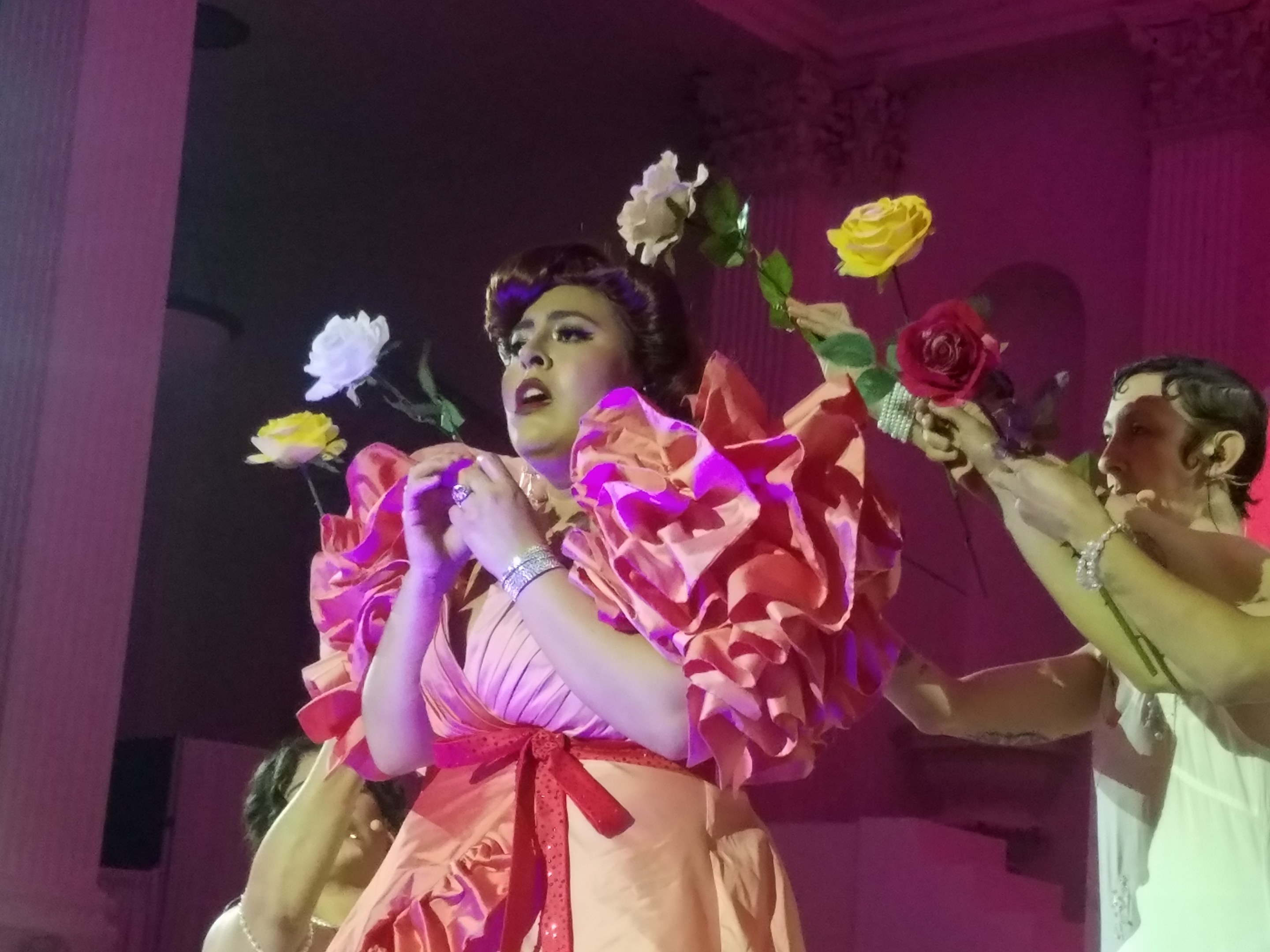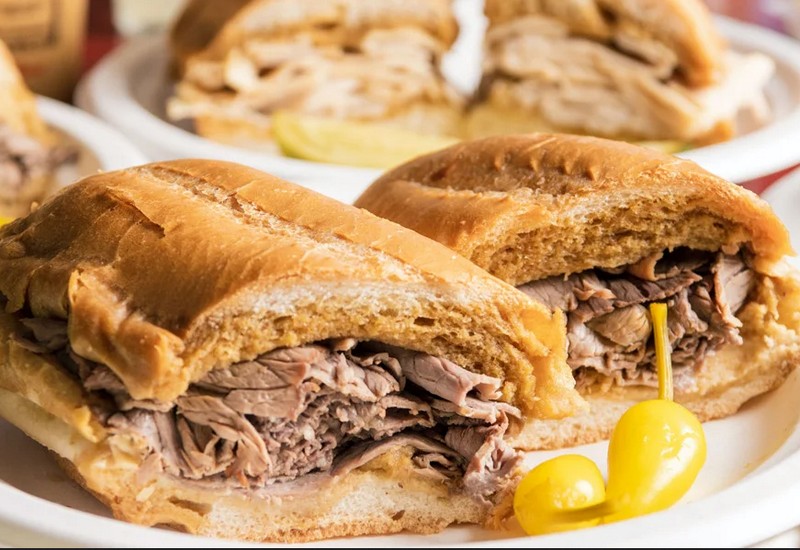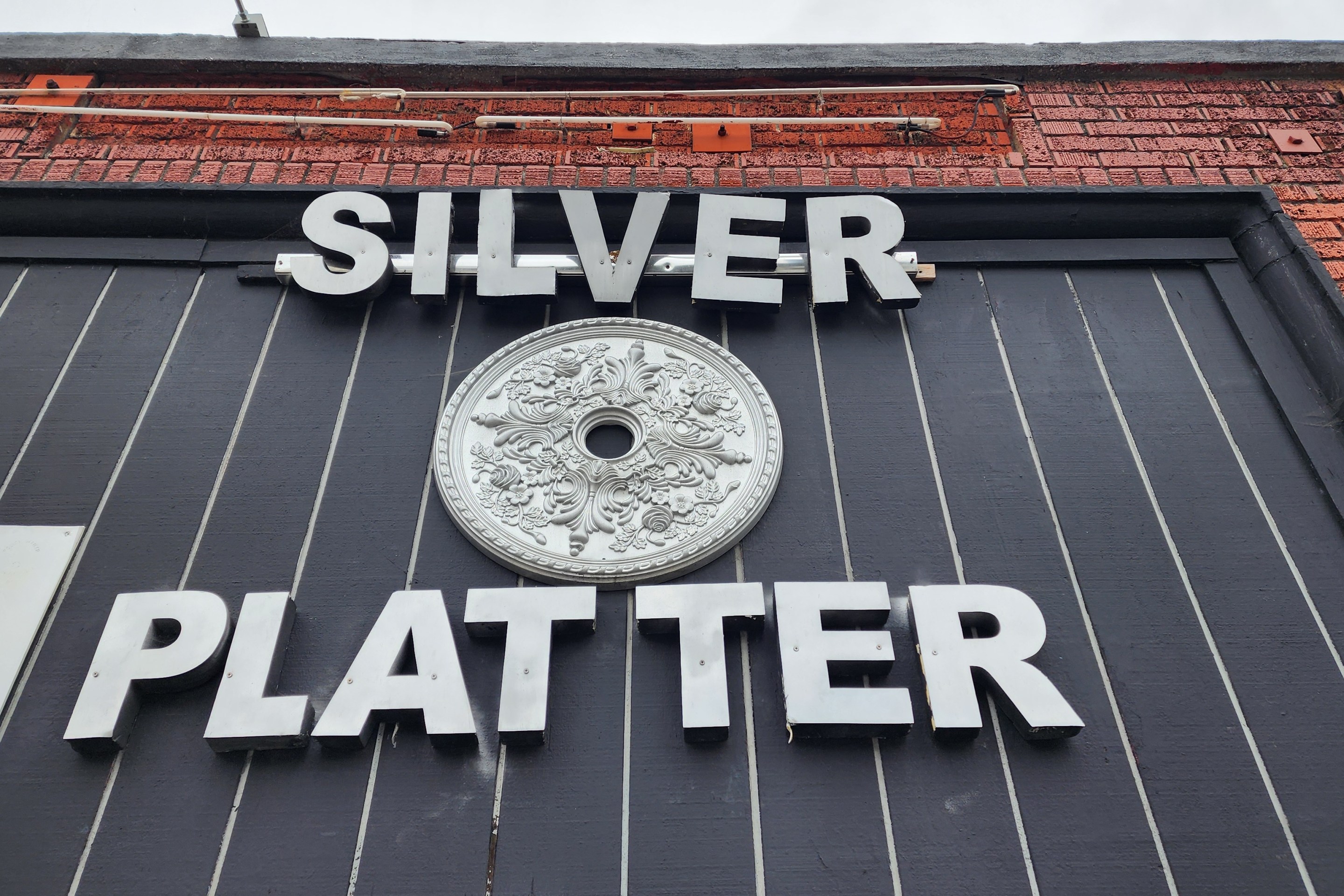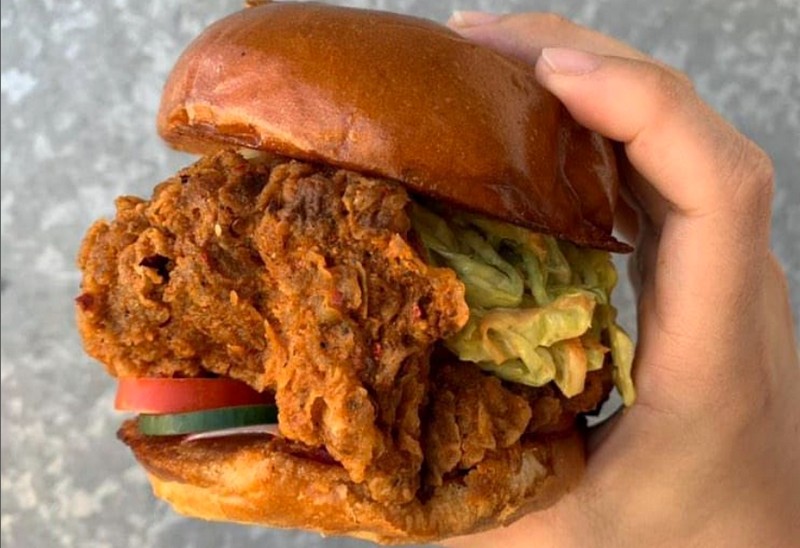[dropcap size=big]T[/dropcap]wo veiled henchman dressed all in black, are dragging a woman in front of a frowning Catholic priestess. Her name is Dolores and she has just been discovered by her husband Salvador, for having an affair with a glowing orb called Esperanza. In defiance, Dolores tumbles and screams across the stage in a ruffly, peach-pink dress.
The scene played out on stage Thursday night at the old St. Vibiana, where Dolores was played by San Cha — the L.A.-based musician known for queering up cumbias with a mix of punk, ranchera, and electro — for a one-night-only performance of her queer telenovela, La Luz de la Esperanza.
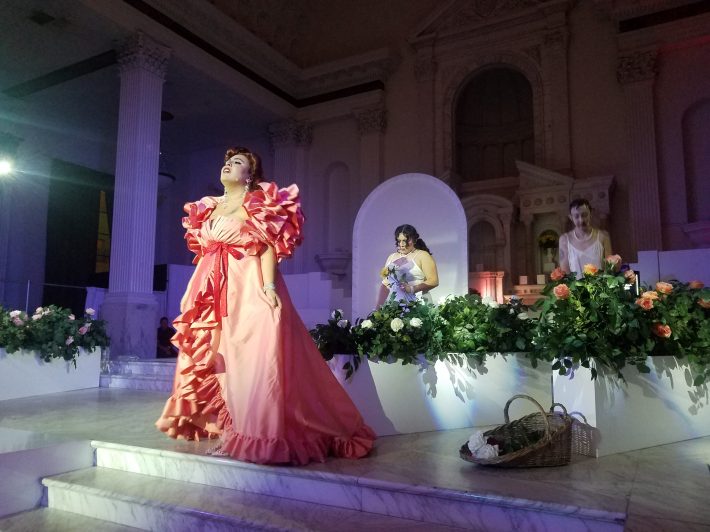
This is a telenovela re-imagined, with traditional motifs of romance, propriety, and gender roles thrown out the church window. The live-action telenovela is divided into two acts, and tells the tale of Dolores, who is played by San Cha, a poor farm girl falls in love with Salvador, a rich man with an estate.
In this show, we can see a blend of San Cha’s influences, from Gloria Trevi’s snarls to Las Jilguerillas with their songs of about life en el rancho. Aside from San Cha’s vocals that can hit the high notes required to viscerally show the pain found in rancheras and the hit songs from some of our favorite novelas, Esperanza was a show for the senses. With wardrobe by OLIMA and Ana Margoth Lima, and hair and makeup by Nena Lady Soulfly under the creative direction of Haus of Urheinous.
Music for La Luz de la Esperanza is what San Cha describes as “slow disco” because of the genre’s “illusion of glamour,” as well as a blend of San Cha’s ranchera-inspired vocals, heavy keyboards, rock and cumbia. The songs are in English and Spanish, and the story’s emotions are understood through San Cha’s performance.
Backup vocalists Lou Coy, Rhea Tepp and Linda Tovar who at times also acted resembled that of a chorus in a Greek tragedy. They appear on stage in bedazzled white slips, and act as Dolores’ fellow farmworkers and bridal party.
RELATED: Feminist Food and the 'Queerest Coffee' in Long Beach ~ Wide Eyes Open Palms
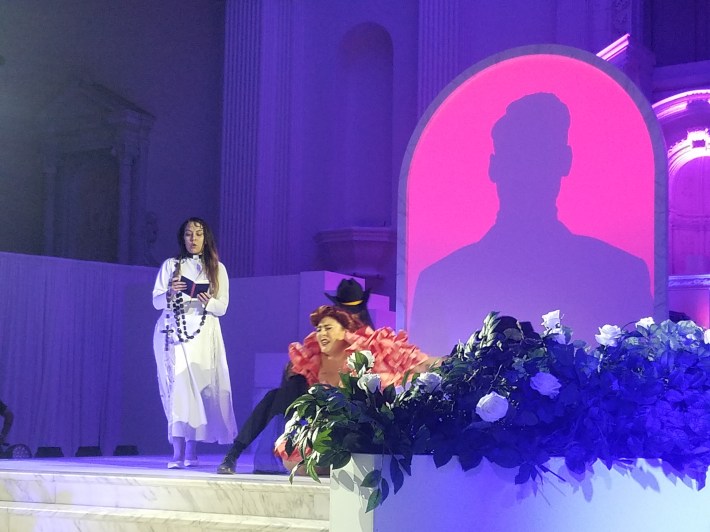
[dropcap size=big]L[/dropcap]a Luz de la Esperanza has been years in the making, when San Cha was still living in the Bay Area, but was able to come to fruition when she was given artistic freedom and resources which included studio time by the Red Bull Music Festival. Since then, San Cha and her team of musicians, stylists and visual artists had two months to rehearse. What started with 17 songs was cut down to 13.
San Cha says her telenovela was inspired in part by Marimar, the 1994 novela starring Thalia. It’s your stereotypical rags-to-riches story of Marimar, a poor girl who lives in a shack on the beach. The son of a wealthy landowner agrees to marry her, but not before Marimar learns the customs and idiosyncrasies of the upper class.
Esperanza differs in that Dolores, played by San Cha, gets the guy, but the story takes a turn as Dolores falls out of love with her new man and new life.
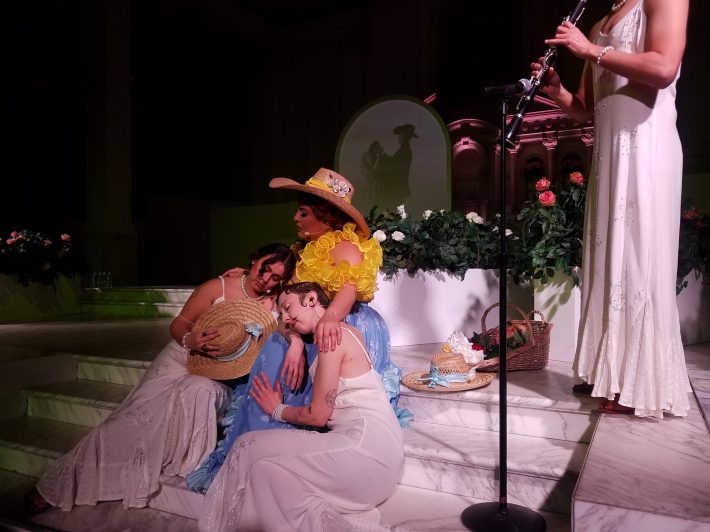
“I was also thinking of that Pimpinela song, ‘Me hace falta una flor,’ the man in Pimpinela, is like, ‘I’ve given you a private jet and everything else, what else do you need?’ And she’s like, ‘romance.’ I wanted to play around with that theme of sadness, but having everything,” says San Cha.
San Cha also made a choice to break away from the traditional novela trope that we see in Marimar of showing the impoverished protagonist in tattered clothes and dirty. In the first act, San Cha saunters out as Dolores a farm girl wearing a straw hat, but she is also wearing a ruffle yellow blouse and a blue satin peasant skirt bedazzled with rhinestones and sparkles with short heels.
“I’m just thinking of my own family who’s still living in Mexico, living with dirt floors, but looking fabulous, always looking fabulous,” says San Cha.
San Cha, who is first-generation, shares that even though her mother and her siblings grew up in a small farm in Jalostitlán, Jalisco, they always wore heels and handmade dresses, even when shopping for groceries.
RELATED: Lesbian, Latina, Large: The Unapologetic Artwork of Laura Aguilar ~ An Image Gallery
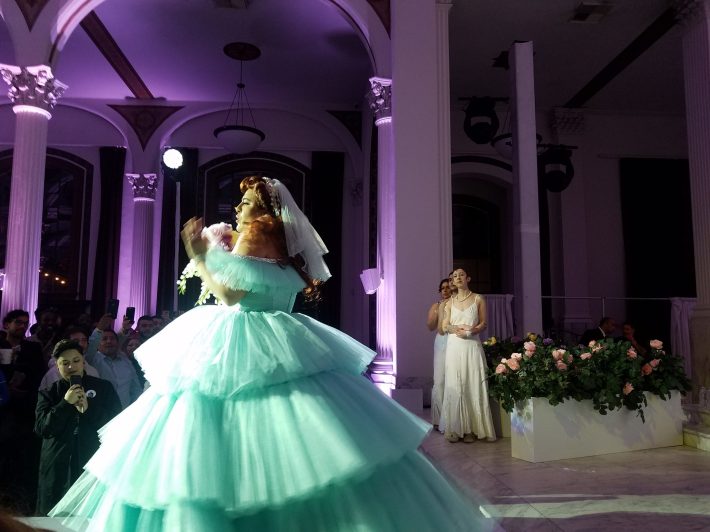
Vibiana, the event space, lends itself beautifully to the telenovela theme. For those of us Angelenos who remember when the event space was the Cathedral of Saint Vibiana, the stage, which was once an altar, is the perfect setting for a novela.
The religious iconography may have been removed, but with plastic red and pink roses and an arch-shaped screen where projections of Salvador are played, it is the setting for a lavish wedding in the first act.
Los Angeles’ Chicana folk trio La Victoria, serenaded the audience with mariachi ballads such as “Qué hermoso cariño,” “Qué bonito amor” and “Si nos dejan” as San Cha changed costumes somewhere offstage.
[dropcap size=big]F[/dropcap]or the wedding scene, San Cha stepped out in an aqua blue chiffon princess gown, entering the stage from the aisle, as images of her waltzing with Salvador are projected on screen. What was especially memorable was the audience participation in the ceremony.
One of the backup vocalists handed out shots of mezcal to various audience members, and San Cha as Dolores tossed her bouquet after singing that she and Salvador were “por siempre juntos.”
Vocalist Linda Tovar had the audience out of the chairs and dancing with her rendition of the staple cumbia of any Mexican party, “Que nadie sepa de mi sufrir.”
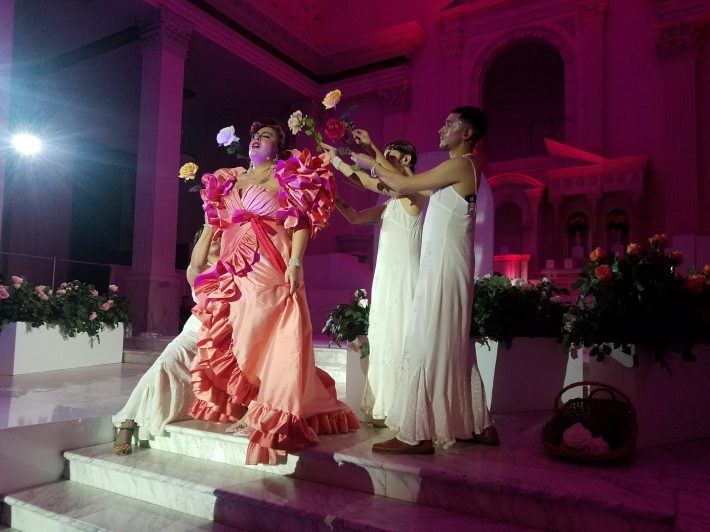
Unlike most telenovelas that end with the protagonist marrying her rich man in the last episode of happily ever after, Esperanza shows what happens when Dolores falls out of love with her fairy-tale romance. Dolores is visited by a spirit that appears as a diamond, prismatic projection named Esperanza in her moments of sadness.
“Esperanza is like an alien, disfigured, isn’t something that she understands. It isn’t this thing that you can go out with and show off to everyone you know, and like, so it’s this love where she starts to fall in love with that instead,” explains San Cha. “It has to do with queerness and figuring out love in ways that maybe you’ve never seen before, or don’t understand.”
Another relationship that inspired her is her friendship with the late Ignacio Nacho Nava Jr., who San Cha credits as her “drag mother,” who took her under his wing when she moved from Mexico to Los Angeles in 2015, where she helped him manage the guest list and count money for his club night Mustache Mondays.
Nava was also her manager along with Rudy Bleu Garcia. San Cha dreamt about Nava a week before his passing, and the performance is dedicated to him.
“He told me that he was helping me out in ways that only he could help me with this performance. I felt like it was his despedida,” she says. The dream inspired her to write a song called "Esta cruz," which is part of the performance.
RELATED: Remembering Ignacio 'Nacho' Nava: Godfather to Downtown’s Queer Club Community Dies at 42
